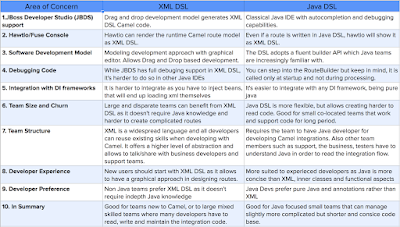(This post was originally published on Red Hat Developers, the community to learn, code, and share faster. To read the original post, click here.)
Apache Camel is a powerful integration library that provides mainly three things: lot’s of integration connectors + implementation of multiple integration patterns + a higher level Domain Specific Language abstraction to glue all together nicely. While the connectors and pattern choices are use case and feature driven and easy to make, choosing which Camel DSL to use might be a little hard to reason about. I hope this article will be able to guide you in you first Camel journey.I work for Red Hat Consulting as an Integration architect and one of my primary goals is to help customers get the design and the architecture of their future systems as right as possible, and consequently get the best value out of Apache Camel. One of the common questions I get at the start of every new Camel based project is: “Which Camel DSL should we use? What are the pros and cons of each?”
I have one good news and one more good news for you. First, by choosing to use Apache Camel you have already done the right choice and Camel will turn out to be a very useful toolkit in your arsenal of libraries for lot’s of future use cases and projects to come. And second, the DSL is just a technicality and it will not impact the success of your project and you can always change your mind later and even mix and match.
If you are a part of large company, with multiple independent two-pizza size teams that use Java language here and there, the chances are that some teams are already using Camel. Even in small companies, teams use Camel without being aware of each other as it is useful for all kind of tasks and a small enough library you to add to your pom.xml and use it without a permission from the technical design board. If that is the case, just talk to your colleagues and learn from first hand their experience with their DSL of choice.
If you need a more comprehensive comparison and a reason to choose one of the DSLs, below is a brain dump from multiple engineers developing developing Apache Camel and consultants using Camel at multiple customer projects across the globe. Pick the arguments that are valid in your context and make your choice.
 |
| Comparing Apache Camel's XML and Java DSLs |
All that said, the only advice I can suggest is strive for consistency. Avoid using different DSLs in the same service, even for different services in the same project. And if you can convince everybody in the company to use the same DSL even better.
Check out my Camel Design Patterns book for more Camel related topoics and follow me @bibryam for future blog posts.








1 comments:
A couple other bonus points for the Java DSL:
- Easier to reduce duplication and maintenance points. Ex: using a constant for commonly-used strings, helper methods to tie common steps into multiple routes, inheritance, etc. The XML DSL typically has more duplication and involves a lot of search-and-replace work. On the flip side, that plays into your points about readability for non Java devs.
- Re: your point about debugging routes, but noting that they're only executed during startup. One approach I've taken is temporarily introducing inline processors within a route, then putting breakpoints there.
Post a Comment